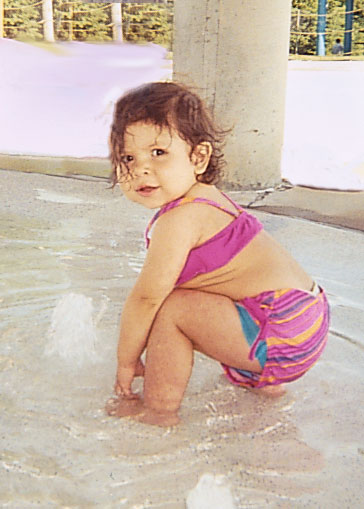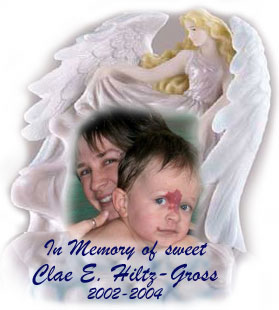|

Basic info for kids:
Many babies are born with birthmarks. Sometimes birthmarks are brown, or pink, or red. They can be anywhere on your body.
Some people have them on their arms or legs. Some babies have them on the back of their necks. Some go away after a while,
but some stay your whole life; or only go away with some help from a doctor.
Aliyah has "port wine stain" birthmarks on her leg, back and arm. When she was born, they were very red and a bit purple.
But now, ithey are light pink. She is not the only one with a birthmark in her family: Her brother has a small brown birthmark
on his cheek
Every other month or so, Aliyah used to go to the birthmark doctor to keep it healthy. It's kind of like going to the dentist
to make sure your teeth stay healthy, or getting a haircut so that your hair stays healthy. The birthmark doctor treats her
birthmark with a special machine called a laser.
The laser makes dots on Aliyah's leg or arm that make her birthmark very purple, instead of the light pink it usually is.
This looks like a boo-boo that hurts a lot, but it doesn¹t seem to bother Aliyah at all. She can touch it and look at it,
and it doesn¹t hurt her. Every day the purple color gets lighter and lighter, until her birthmark is back to being light pink
again; and sometimes it gets even lighter than it was before.
To help the purple dots go away and help it heal better, we put a special lotion, or ointment, on her face.
For teachers/friends (in case you have questions):
A port wine stain (PWS) is a congenital birthmark that affects approximately 3 out of every 1,000 people. Most commonly found
on the face and neck (but can be found elsewhere and may cover up to 2/3 of the body). It usually follows a nerve pattern.
Theories differ as well as definitions, but overproduction of blood vessels or a nervous system deficiency in-utero seem to
be the most likely cause. According to our research, it happens very early in the pregnancy.
Some people think, like most birthmarks, that a port wine stain is a skin pigmentation issue. In reality, PWS has nothing
to do with the pigment in Aliyah's skin. Instead, the red/pink you see is the underlying dilated blood vessels. The easiest
way to describe it is to picture normal blood vessels as angel hair pasta. Aliyah's port wine stain is made up of linguine
blood vessels, that are more lax and don't constrict like normal blood vessels. When she gets cold (and more blood goes to
her limbs) the birthmark appears darker. Other times it can be almost invisible. When a pws is on the face, vessels can enlarge
with age--if left untreated, the vessels may become enlarged and elevate the skin causing the surface to take on a cobbly
appearance. Occassionally the vessels can create "exaggerated growth," such as a fatter upper lip or swollen cheek where the
birthmark appears (they think it's from all the extra blood flow feeding the tissues and such there).
PWS are present at birth and usually clearly visible. The vessels are also more numerous. PWS grow with the person and never
regress. (In other words, as Aliyah gets bigger, her birthmark grows with her proportionately.) If left untreated, in time,
particularly in the facial area, some develop a purple color and the birthmark gets thicker. In some rare instances a PWS
may be a marker for another associated syndrome such as Sturge Weber. The problems of PWS can now be treated by laser.
How a laser works to treat a birthmark:
The laser can be "tuned" to various wavelengths. With different wavelengths a laser beam can be made to react upon materials
of only certain colors and densities. One way to think of it would be to picture an inflated colored balloon inside of a clear
inflated balloon. A laser beam can pass through the clear balloon, leaving it intact yet exploding the colored balloon inside.
The laser beam is "tuned" to only affect the material of the colored balloon. This is quite similar to how a medical laser
is used to clear or fade a birthmark. The laser is "tuned" to only affect the darker more dense blood vessels deep in the
skin that cause the birthmark, leaving the lighter less dense outer skin with minimal damage.
Unfortunately, at this time, most people do not see complete removal of their birthmark by laser treatments.
10%-15% of those treated see 75%-100% fading
70%-80% see 25%-75% fading,
and 10%-15% see 0%-25% fading.
Text and graphics courtesy of birthmark support group parents/members and various websites about birthmarks
Some celebrities with PWS
Algunas celebridades con angiomas
|
This page is decicated to Port Wine Stain awareness, please take a moment to read the information below. Aliyah has had laser
treatment and we've seen great results, her birthmarks are much lighter. She is perfect to our eyes, but we believe we can
make it easier on herself if we help her birthmark get lighter.
Esta pagina esta dedicada a informacion sobre angiomas planos, o marcas vino oporto. Por favor lea la informacion siguiente.
Aliyah ha tenido tratamientos y hemos visto resultados muy buenos, las marcas son mas claras. Ella es perfecta a nuestros
ojos, pero si queremos hacer lo posible para ayudar que sus marcas de nacimiento sean mas claras y que ella se sienta bien
consigo misma.
| FOR MORE INFORMATION & SUPPORT VISIT |

|
| PARA MAS INFORMACION & AYUDA VISITE |

Explicacion simple para niños
Muchos bebes nacen con marcas. A veces son cafes, rosadas o rojas. Pueden estar en diferentes partes de tu cuerpo. Algunas
personals las tienen en sus brazos o piernas, algunos bebes las tienes en el cuello. Unas marcas desaparecen despues de un
tiempo, pero otras son para siempre o solo desaparecen con la ayuda de un doctor. Aliyah tiene "angiomas planas" o marcas
vino oporto en su pierna, espalda y brazo. Cuando ella nacio eran moradas oscuras, ahora son rosadas claras. Ella no es la
unica con marcas de nacimiento, su hermano tiene una pequeña marca en su mejilla.
De ven en cuando Aliyah va a un doctor para mantener la marca sana. Es como ir al dentista para mantener los dientes sanos
o como un corte de cabello para mantener tu cabello saludable. El doctor trata su marca con una maquina llamada laser.
El laser deja pequeños circulos morados en la pierna o brazo de Aliyah. Parecen heridas dolorosas, pero a Aliyah no parece
molestarle. Ella las puede tocar y no le duelen. Cada dia el color morado de vuelve mas claro hasta que desaparecen, y la
marca se ve mas clara que antes. Le ponemos una crema para que la piel se sienta mejor
Informacion para adultos (amigos/maestros)
¿Pueden causar algún tipo de problema?
Los hemangiomas verdaderos tienen algunas complicaciones y las manchas vino de oporto al madurar tienden a provocar hipertrofia
de tejidos blandos, tomar un color más oscuro y desarrollar nódulos en la superficie. Está bien identificadas (incluso hay
libros sobre el tema), las alteraciones psicológicas que sufren los pacientes. Una mancha de este tipo puede ser un estigma
para una persona, especialmente si aparece en un lugar muy visible, como la cara. Desde que un niño nace con ella es observado
de forma diferente, cuando tiene contacto con otros niños, se burlan de él, le ponen apodos y esto causa problemas psicológicos
a lo largo de su vida. Esto no sucede en todos los casos, afortunadamente hay pacientes a quienes no les afecta en lo absoluto,
mientras que otros niños podrán requerir apoyo psicológico.
¿Cuál es el tratamiento más adecuado para un angioma plano?
Antes de que existiera el tratamiento con láser, se utilizaron varias opciones; una de ellas era la cirugía. Los resultados
eran peores que el mismo hemangioma porque quedaban cicatrices muy notorias. Era muy difícil corregir el aspecto que quedaba
al eliminar una lesión vascular en la cara. En algunos casos se recurría a la radiación, pero a la larga podía provocar cáncer
de piel. También se utilizaba el nitrógeno líquido, pero dejaba unas cicatrices terribles y no eliminaba por completo la lesión
vascular. Cuando comenzó a utilizarse el láser para estos casos, existía el láser de argón, pero tendía a dejar cicatrices.
Desde los años setenta se desarrollaron técnicas de láser específicas para tratamientos de lesiones vasculares, entre ellas
el láser de colorante pulsado y posteriormente otras tecnologías que tienen una longitud de onda muy específica y que trabajan
a través de fototermólisis selectiva o daño térmico selectivo. Esto significa que la luz del láser va a ir dirigida contra
un cromóforo o un agente específico, sin dañar alguna estructura vecina o que se encuentre cerca del lugar a tratar. En el
caso de un hemangioma el láser va dirigido contra la hemoglobina, y va sellando los pequeños vasos sanguíneos. De esta manera,
los vasos que están anormalmente dilatados, se van cerrando y recuperan su grosor normal. En ciertos casos muy específicos
se utiliza una combinación de terapias para lograr una mejor recuperación de la piel.
No se puede remover estas marcas por completo con tratamientos de laser, se aclaran pero no desaparecen. Estos son los resultados:
De 10%-15% personas con tratamiento 75%-100% resultan en aclaramiento
70%-80% ven 25%-75% de aclaramiento,
y 10%-15% ven 0%-25% de aclaramiento.


|












